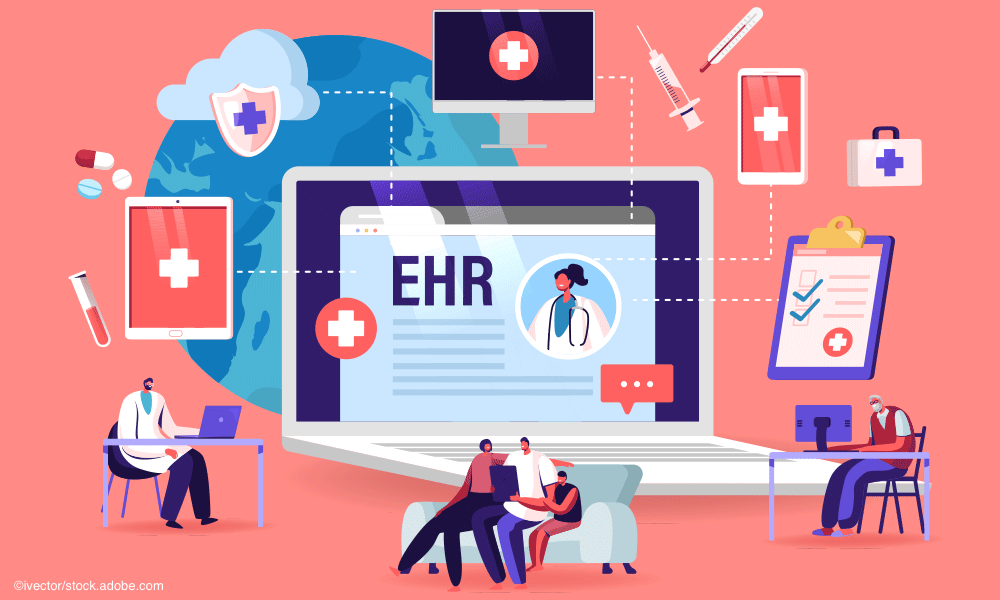Optimize your EHR now
Even during market disruptions, physicians need to create efficiencies, cut costs, and boost financial stability.
© ivector - stock.adobe.com

Electronic health record (EHR) optimization is about to get more challenging, but there are ways for organizations to prepare now. With a potential economic downturn still looming, a labor shortage in professional services and continued supply chain disruptions, overhauling, enhancing, or implementing an EHR system may seem daunting. Physicians, provider operations executives, and revenue cycle leaders should be aware that optimizing these systems is critical for creating operational efficiencies, reducing high administrative costs, and improving financial stability. There are a variety of ways to get the most out of your EHR system, but here are some ways to optimize your organization’s EHR system during a time of continued disruption to help achieve your business objectives.
Know your EHR system
It is important to understand the functionality and benefits of the tools your organization has already implemented but may not yet be adopted by your department or other departments. It is also crucial to know how updates or available features of your current EHR or a new system could impact overall business goals and drive value. Knowing the capabilities of an EHR system could reduce the need for a third-party system, decrease overall application and reskilling costs, and lessen complexities for staff members working in multiple systems.
Improve workflows
Furthermore, an optimized EHR system may enable revenue cycle leaders to improve workflows, catalyze queues of denials or referral responses, and improve scheduling templates to open access. Improving workflows through EHR optimization also creates an opportunity to reduce open encounters and lag charge times by enhancing clinical documentation tools and templates.
With continued labor shortages of frontline workers and back-office talent, it is more important than ever to ensure that digital solutions are integrated and implemented to reduce administrative burdens and increase provider and patient satisfaction. EHR systems can be improved with optimized dashboards that include analytics for key metrics such as denials or provider efficiency metrics, which can help leaders determine where their staff should focus. By taking advantage of automated workflows and activities where possible and ensuring the system provides support to both the provider organization and providers themselves, you may reduce provider moral injury and lessen the impact of labor shortages.
Simplify satisfaction
Right now, improving the patient experience is crucial across all provider organizations, as many patients are increasingly dissatisfied with their care and some may even be choosing to defer care altogether. A recent AP-NORC poll found that eight in 10 Americans are at least moderately concerned about getting access to quality healthcare when they need it.Ease of access to telehealth and urgent care services, as well as increased consumerization of healthcare, continues to impact patient loyalty. Optimizing your EHR system can help enhance the patient's experience by simplifying the referral process among patients and providers.
Optimizing your EHR system can also boost the efficient use of the patient portal and empower patients or their caregivers to take the lead on managing care. A developed patient portal facilitates online appointment self-scheduling, allows patients to update their medical information, and offers the option to revise current medications. Mature patient portals can also simplify online check-in and arrival, online bill pay, and the patient’s ability to obtain their records and visit notes. An optimized EHR system and patient portal creates real-time access to patient data for patients, their caregivers and other providers in a way that was not possible before digital transformation. The ability for provider organizations and healthcare workers to share patient data more effectively may also lead to better, more personalized treatment.
It does not have to be expensive
If a complete overhaul of your organization’s EHR system is out of the question, you can still make measurable, meaningful change. Building and re-establishing relationships with patients should be top of mind for all provider organizations, so a good starting point is to optimize the patient portal. Another opportunity organizations can take advantage of is to make the most of the reports, dashboards, and other functionalities that your current EHR system offers. Use the technology you have to its fullest potential: EHR systems have the tools to generate documentation and ordering efficiencies for a high revenue-generating specialty — or you can use these tools to take a struggling specialty and improve its documentation and reporting.
The adoption — and optimization — of EHR systems not only has the potential to create operational efficiencies and lead to better outcomes for provider organizations, but may also improve patient care with faster, safer and more cost-effective decision-making. By optimizing your EHR system now, your organization will be better equipped to address future challenges in healthcare, the workforce, and the economy.
Julie McGuire, RN, MSN, is a managing director in BDO’s Center for Healthcare Excellence and Innovation with more than 25 years of experience in healthcare and 15 years of experience collaborating with operational and clinical partners on delivering and transforming technology to new and existing facilities and services. BDO USA delivers assurance, tax, and financial advisory services to clients throughout the country and around the globe and is a member of BDO International, the world’s fifth-largest accounting network.
Specialty telemedicine for independent practices
March 29th 2021Physicians Practice® spoke with Dr. Jonathan Wisen, Founder and Chief Medical Officer of MediOrbis, about specialty telemedicine for the treatment of chronic conditions and how these technologies can improve a practice's offerings and patient outcomes.